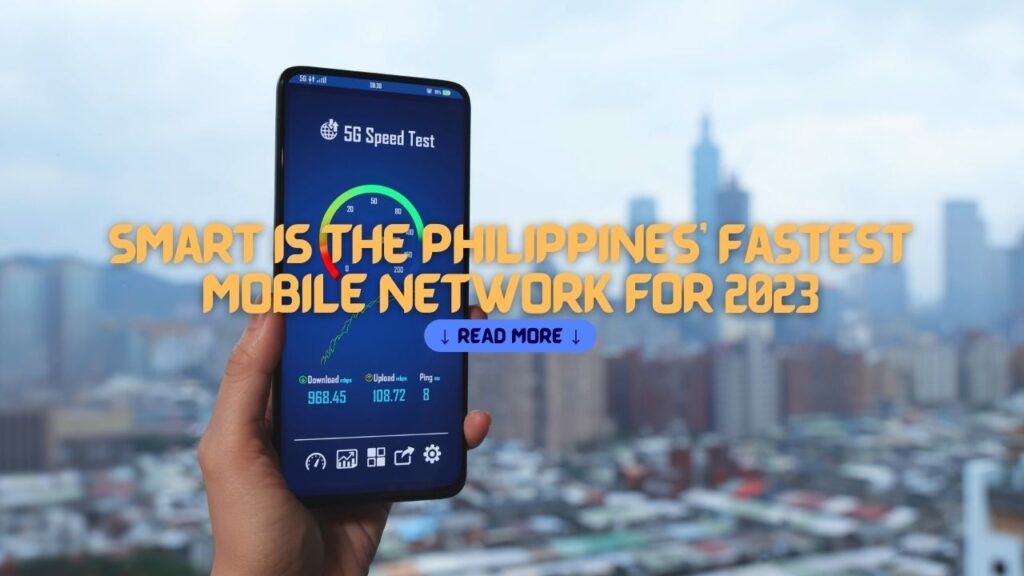Smart leads once again with the fastest median download speeds, affirms Ookla Q4 2023 Report
8 min read
Smart continued to deliver the fastest median download speed in Q4 2023, according to the latest Speedtest Intelligence report by Ookla.
In the ever-evolving realm of telecommunications, maintaining the lead in internet speed is a testament to a company’s commitment to technological excellence and customer satisfaction. Smart Communications Inc., a key player in the Philippine telecom industry, has consistently held this prestigious position. According to the latest data from Ookla, the global leader in internet testing and analysis, Smart has retained its status by offering the fastest median download speeds in the country for the fourth quarter of 2023.
The Q4 2023 Ookla Speedtest Global Index Report highlights Smart’s achievement in delivering superior internet speeds to its subscribers. This accomplishment is particularly significant with the robust growth of digital communication and the continuous demand for high-speed internet. Smart’s ability to provide quick download speeds is not only crucial for individual users seeking seamless online experiences but also for businesses relying on rapid data transfer to remain competitive in a digitally connected world.
Ookla’s citation of Smart reflects the company’s ongoing investment in network infrastructure and commitment to enhancing user connectivity. By achieving the fastest median download speeds, Smart demonstrates its capability to meet and exceed the demands of modern internet users, securing its reputation as a prominent force in advancing the Philippines’ digital landscape.
Executive Summary of Ookla’s Findings
In the fourth quarter of 2023, Ookla’s Speedtest Global Index revealed that Smart Communications, Inc. maintained the lead as the fastest mobile network in the Philippines. The company demonstrated a median download speed of 37.64 Mbps, distinguishing itself positively from the competition.
Globe Telecom, another key player in the Philippine telecommunications industry, recorded median download speeds that, while competitive, did not surpass those reported by Smart.
DITO Telecommunity, the newest entrant in the market, has been making strides but was not featured as the leading provider in terms of speed in the latest report.
PLDT, Smart’s parent company, has historically contributed to the network’s infrastructure, bolstering its performance and likely playing a role in its current standing based on Ookla’s metrics.
The results of this report impact the Philippines’ ranking in the global broadband speed landscape, highlighting its continued efforts to improve internet connectivity for its citizens.
| Provider | Median Download Speed (Mbps) |
|---|---|
| Smart | 37.64 |
| Globe | 26.44 Mbps |
| DITO | 19.74 Mbps |
Smart’s achievement reflects its commitment to providing a robust mobile internet experience, which is critical as digital connectivity becomes increasingly synonymous with socioeconomic development.
Analysis of Mobile Networks Performance
Smart has established its lead in the latest assessments regarding download speeds, marking a significant trend in mobile network performance.
Smart’s Dominance in Download Speed
Smart’s continuous lead in the Speedtest Global Index reflects its robust infrastructure and technological investments. Their median download speed hit an impressive figure of 37.64 Mbps, showcasing their commitment to providing superior service.
Comparison with PLDT Group’s Results
Notably, Smart is a subsidiary of the PLDT Group, which aligns its results with the group’s overall performance. The consistent upgrades in network infrastructure have cumulatively positioned the PLDT Group prominently on the leaderboard for download speed metrics.

Technical Insights on Network Speed Tests
Technical analysis of network speed tests reveals intricate details about connectivity performance. This section delves into the methodology of Speedtest by Ookla and the significance of median speed metrics in assessing network speeds.
Understanding the Speedtest Methodology
Speedtest by Ookla is the industry standard for measuring internet performance. It evaluates various networks, including 3G, 4G/LTE, and the latest 5G technologies. The test runs by establishing multiple connections to a server and then measuring the speed at which data is downloaded and uploaded. It also captures the latency during the process, affecting the network’s responsiveness.
- Key Components Evaluated:
- Download speed
- Upload speed
- Latency (ping)
Importance of Median Speed Metrics
Median download speed is a critical metric because it represents the middle point of all measured speeds, effectively nullifying outliers. Unlike average speeds, the median is not skewed by extremely high or low results, offering a clearer picture of the typical user experience within a network.
- Why Median Speed Matters:
- Reliability: It reflects the performance that most customers can expect.
- Benchmarking: Ookla’s Speedtest Awards often use median speeds as a key indicator for the Fastest Mobile Network award.
Precise metrics are essential when gauging a network’s capabilities and users’ expectations for services reliant on solid internet connectivity.

Regional Network Speed Variations in the Philippines
In the Philippines, significant differences in network speeds were observed across various regions, with Metro Manila leading in connectivity, followed by urban centers like Cebu City and the Davao Region, reflecting the disparate distribution of mobile network performance.
Metro Manila’s Network Analysis
In Metro Manila, the average mobile coverage and speed are at their peak due to dense infrastructure and technological investments. The city’s users experience the highest median download speeds, primarily attributed to intense competition among providers to be recognized as the Best Mobile Network. Data reveals that mobile users in this area have the most consistent access to fast speeds, maintaining their lead in the latest Ookla reports.
Cebu City and Davao Region’s Connectivity
Moving to Cebu City and the Davao Region, mobile coverage remains strong but shows variability in network speeds. Cebu City, a growing urban hub, is catching up, with improved infrastructure leading to increased download and upload speeds. The Davao Region, while more expansive and geographically diverse, presents challenges that lag slightly behind Cebu City in terms of network robustness. Providers in these areas continue to invest in network enhancements to close the gap with Metro Manila.
Mobile Operators and Consumer Experience
Smart Communications, once again, distinguishes itself by offering the fastest median download speeds according to the latest Ookla report for Q4 2023. For consumers, this means a dramatically smoother and more responsive internet experience, particularly when streaming media, downloading content, or engaging in online games where speed is crucial.
Competing in the same sphere, Globe Telecom and DITO Telecommunity also strive to provide quality service but have trailed behind Smart in terms of download speeds. The impact on customer experience can be significant as mobile users often equate network speed with overall service quality.
Mobile coverage also plays a pivotal role; a high-speed connection loses its edge if it is not widely accessible. Here, Smart leads with notable coverage, making its swift connections more reliably available to a larger population segment.
Consumer satisfaction is a multidimensional construct, and these key players continually adapt to meet the rising expectations. They don’t just focus on speed and coverage but also customer service and diverse plan options.
| Smart | Globe | DITO |
|---|---|---|
| Fastest Download Speed | Broad Coverage | New Entrant |
| Excellent Coverage | Diverse Plans | Competitive Pricing |
Customers often base their choice of mobile operator on a blend of these factors. While speed and coverage are critical, transparency in pricing, customer service responsiveness, and additional perks can sway consumer preference. Operators are not only competing on a technical front but are also working to enhance the holistic user experience.
Mobile Devices Impact on Network Experience
The network experience on mobile devices can vary significantly depending on the device’s capabilities and the electronic brand’s technological advancements. Users often see a marked difference in cellular network performance across different devices, particularly when comparing models from premium electronic brands.

Benchmarking Premium Electronic Brands
When benchmarking network experience, premium electronic brands like Apple and Samsung generally lead with more advanced features that facilitate faster download and upload speeds. However, for the 2023 report, Xiaomi’s Poco F5 is a surprise performer, being the best device next to Apple’s iPhone 15 Pro Max. Ranking third is the Samsung Galaxy S23 Ultra, which has state-of-the-art 5G capabilities that ensure a superior network experience. The previous model, the Galaxy S22 Ultra, also boasts impressive connectivity features, but the S23 Ultra’s refined technology gives it an edge in network performance metrics.
On the other hand, Apple’s iPhone 15 Pro Max claims enhanced data throughput thanks to its custom-designed antennas and radio components, supporting a comprehensive range of 5G bands. Such features are critical in achieving the fastest median download speeds reported by Ookla’s Q4 2023 report.
Understanding Device-Related Network Performance
Specific components in mobile devices, including modems and antennas, profoundly impact network performance. Apple, Samsung, Xiaomi, Huawei, and Infinix provide various models that cater to different market segments, each with differentiated network capabilities.
For instance, premium models typically incorporate advanced modem technologies that optimize signal strength and throughput, directly translating to faster download speeds and a more responsive network experience. This can be seen in the Samsung Galaxy S23 Ultra‘s use of the latest Qualcomm X-series modem, demonstrating how key hardware components contribute to overall network performance.
Device-related network performance is not just about hardware capabilities; it’s also about how well the device’s software integrates with network technologies. The seamless interaction between a device’s operating system and its modem dictates how effectively it can leverage available network speeds—even when the network can deliver high performance, as outlined in reports of PLDT subsidiary Smart’s network speeds.
Societal and Developmental Impact of Mobile Network Advancements
Mobile network advancements, particularly deploying 5G networks by providers like Smart Communications and DITO Telecommunity, contribute significantly to societal and developmental goals. The infrastructure developments align with the UN Sustainable Development Goals, specifically SDG No. 9 – Industry, Innovation, and Infrastructure.
The Philippines’ Best Mobile Network initiatives have demonstrated a vital role in enhancing connectivity and fostering innovation. Improved mobile network performance leads to better communication, greater access to information, and the facilitation of cutting-edge services across multiple sectors.
Key Impacts:
- Economic Growth: Accelerated digitalization drives economic activity by enabling new business models and services.
- Education: Enhanced network speeds improve access to educational resources, allowing for interactive and remote learning experiences.
- Healthcare: Telemedicine and real-time data transmission improve patient outcomes and healthcare management.
- Rural Development: Expanded network coverage, including remote base stations, reduces the urban-rural divide, bringing opportunities to underserved areas.
This development in mobile networks is particularly noteworthy in the Philippines, where companies strive to be recognized as the fastest and most reliable service providers. The competition enables a more robust infrastructure that fosters economic opportunities and enhances its citizens’ overall quality of life.
Like, Follow, and Subscribe to OutofTownBlog.com on Facebook, Twitter, Instagram, and Pinterest, and Team out Of Town on YouTube for more updates.
Read: PLDT introduces the next generation of Fiber, starts roll out of ultra-fast Gigabit Fiber plans





